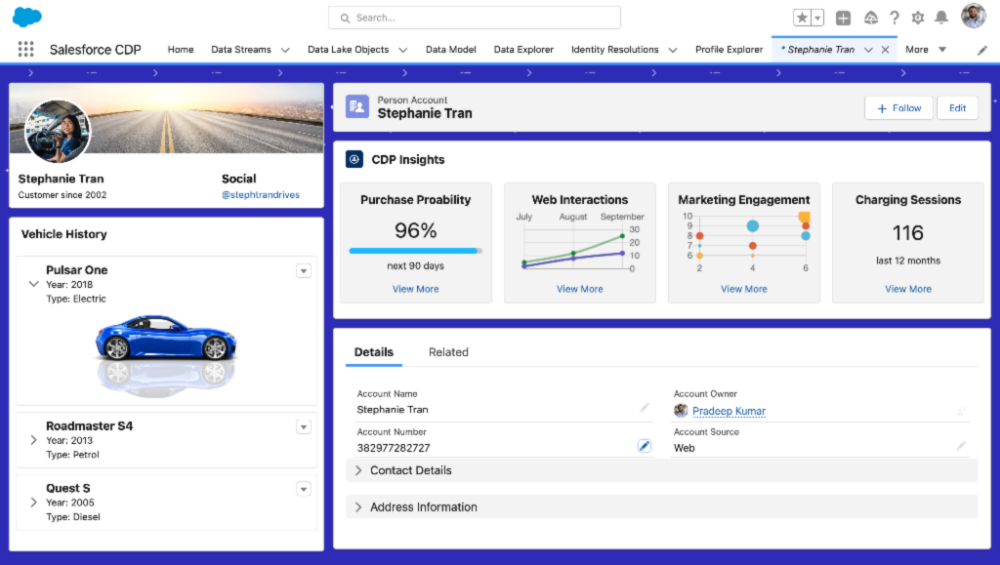At Dreamforce this year, we introduced Data Cloud, the customer data platform that enables businesses to deliver customer magic. In this blog post, we’ll give you an overview of Data Cloud, and how you, as a developer, can prepare for the future of real-time data, intelligence, and automation.
Introducing Data Cloud
Data Cloud is a real-time, hyperscale data platform that combines a data lakehouse architecture with metadata. It enables you to bring together large volumes of data and the capabilities of the Salesforce Platform, including Salesforce Einstein and Salesforce Automation. The Salesforce Platform is great for building rich and engaging transactional applications. But, in this modern consumer-oriented digital world, knowing your customer requires more data, such as web/mobile clicks and device signals.
Data Cloud brings together the power of Salesforce with the benefits hyperforce. It combines our metadata, packaging, APIs, and experiences with public cloud data scale, latency, and processing.
Data Cloud’s lakehouse architecture allows you to extend the data that you already have as part of your CRM. As a developer, this gives you the opportunity to think of all the customer touch points that you may have not been able to use in the past due to large data volumes or storage limitations.
Some examples of data points that you can start to use include:
- Contacts, leads, cases, activities, and so on in one or multiple Salesforce orgs
- Email and web interactions on your marketing channels
- Commerce activities (online and in-store)
- Third-party systems like your custom IoT solution

Bringing it all together
With Data Cloud, you can now bring all that data — and more — into a single source of truth. High-scale data ingestion, data transformation, and unification in real-time with a single customer profile are all handled by the platform.
When you put all of this into perspective, complex use cases can become easier to implement once all of these processes are managed by the platform.

Let’s take an automotive company as an example. With real-time data, you can map out and integrate data into Data Cloud from across your technology landscape to create a more robust view of how a person is interacting with your brand. Imagine if you could access telematic data from your cars and inventory data from your ERP, bring it all together, and map it to your customer data. With Data Cloud, you’ll be able to unite that data in one place and use it to improve marketing, sales, service, and any applications in Customer 360. You’ll be able to let the sales team know what’s in their customer’s garage, but also what cars they’re looking at online. At the same time, you can let your service team know the status of their inventory before putting a service request together.
With real-time intelligence, you’ll be able to take that vast amount of data and drive predictions and analysis using Salesforce Einstein. Data Cloud takes care of the overhead that data scientists carry when trying to do massive data migrations just to perform an analysis. Einstein also enables you to run no-code predictions and create insights with your own machine-learning models in the future. For example, you could use it to take a deeper look into customer demographics and identify trends around future car ownership and target customers with the right offers in real time.
Then, with real-time automation, you can use the best-of-breed capabilities already provided by the Salesforce Platform to bring together multiple applications and create a journey for your customers. This could be a massive opportunity for a company to change its marketing program based on a customer’s satisfaction level in CRM, as well as their open support tickets. Imagine the ability to use a chatbot that helps a customer set up a service appointment when the car telematics show that they have hit 100k miles.
All data within Data Cloud is built on specialized, and customizable data models (prefixed with ssot__), that work in a similar way to other objects within a Salesforce org. There are also industry-specific data models available to help you design your single source of truth. As a developer, you are likely already familiar with how those are defined (e.g., the Sales Order data model). Once data has been processed and matched, it is accessible right inside Apex by using the CDP Methods provided by the Connect API (more on that in a later blog post).
As Data Cloud is an open platform, you can ingest and utilize the data across various APIs, which we’ll also cover in an upcoming blog post.
Conclusion
As a developer, Data Cloud opens up a brand new world of real-time data, automation, and intelligence. You’ll finally have access to more data than ever before, and be able to truly bring together tools that have been difficult to integrate in the past. Over the next few posts, we will be taking an in-depth look into the technology behind Data Cloud and how you can get started.
For now, check out the following resources to learn more:
Salesforce Data Cloud: Quick Look on Trailhead
Dreamforce Developer Keynote: The Future of Development
Salesforce Data Cloud Developer Guide
About the author

Stephan Chandler-Garcia is a Senior Developer Evangelist at Salesforce. He focuses on application development, security, and Experience Cloud. You can follow him on Twitter @stephanwcg.